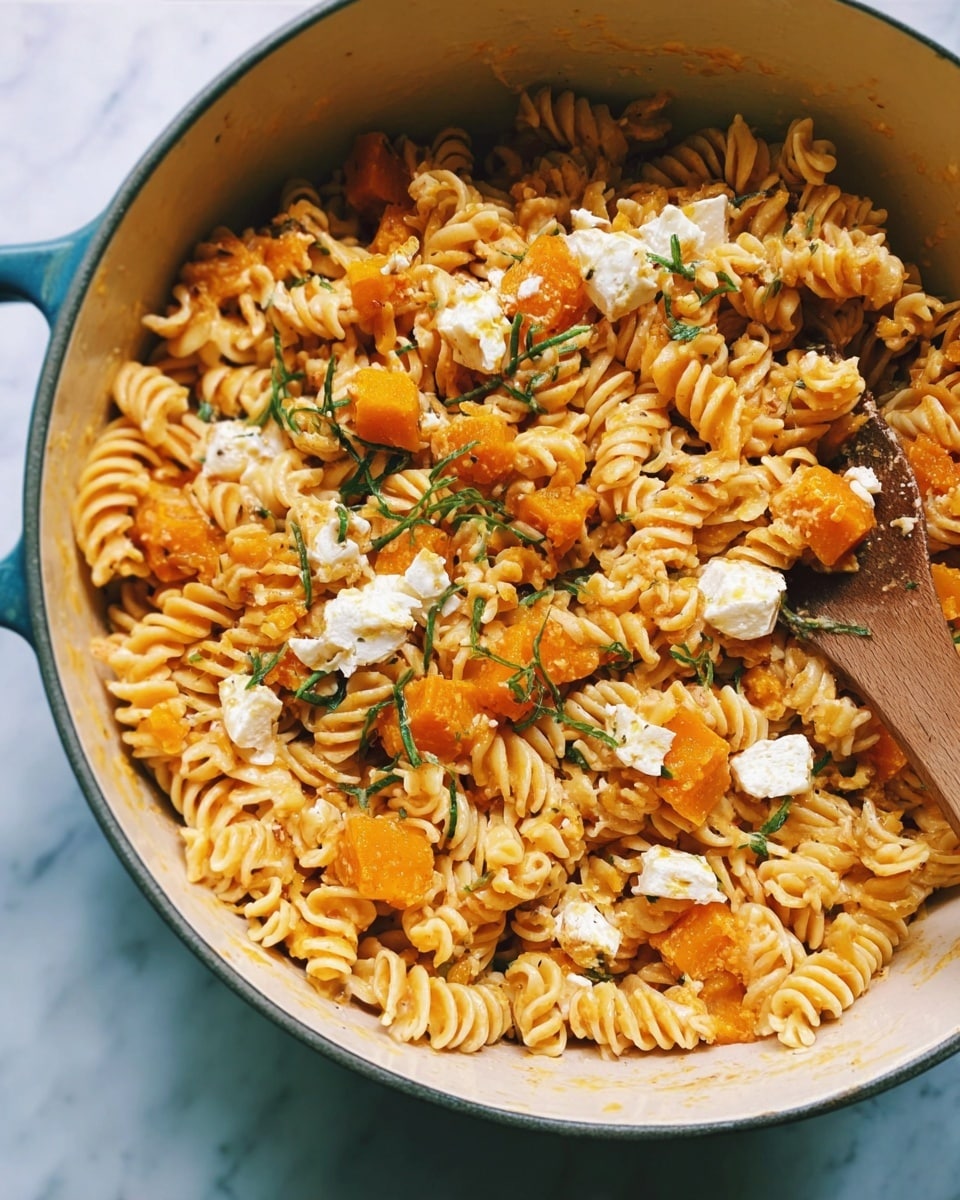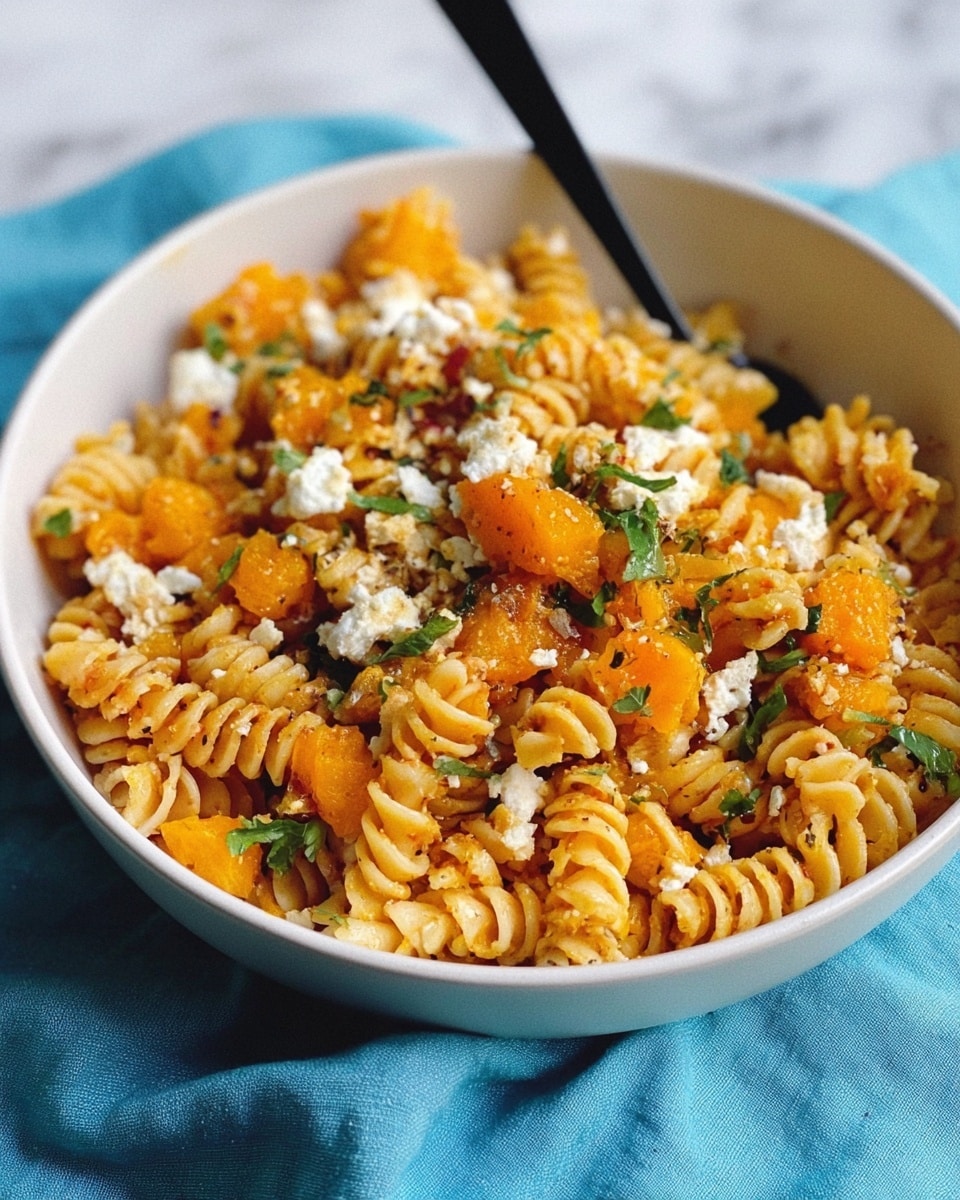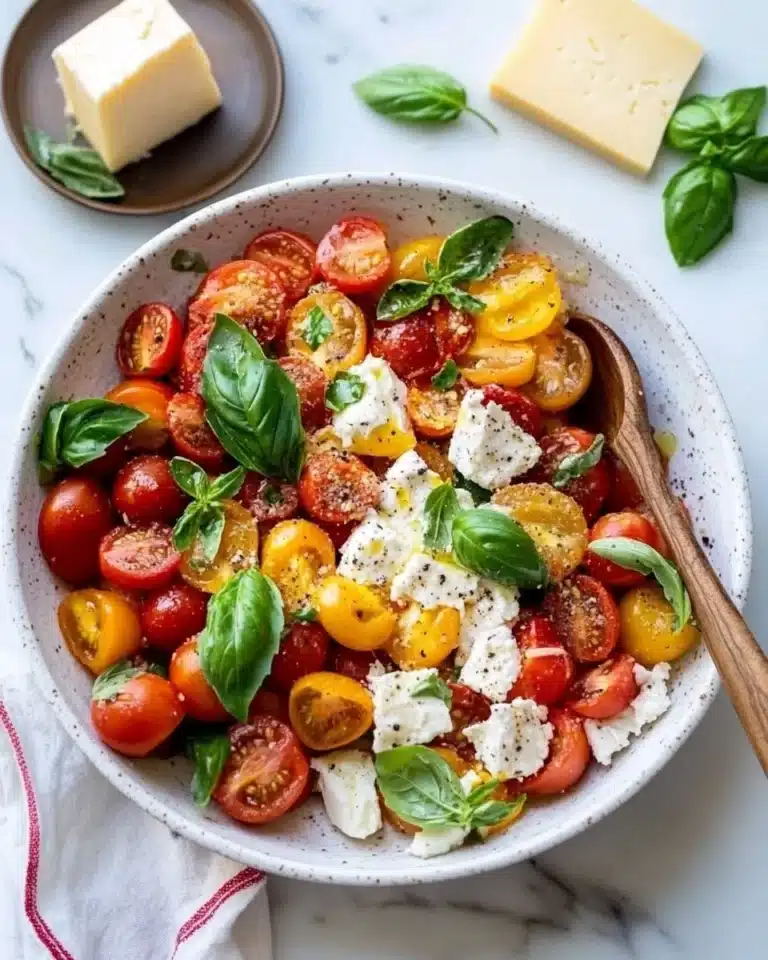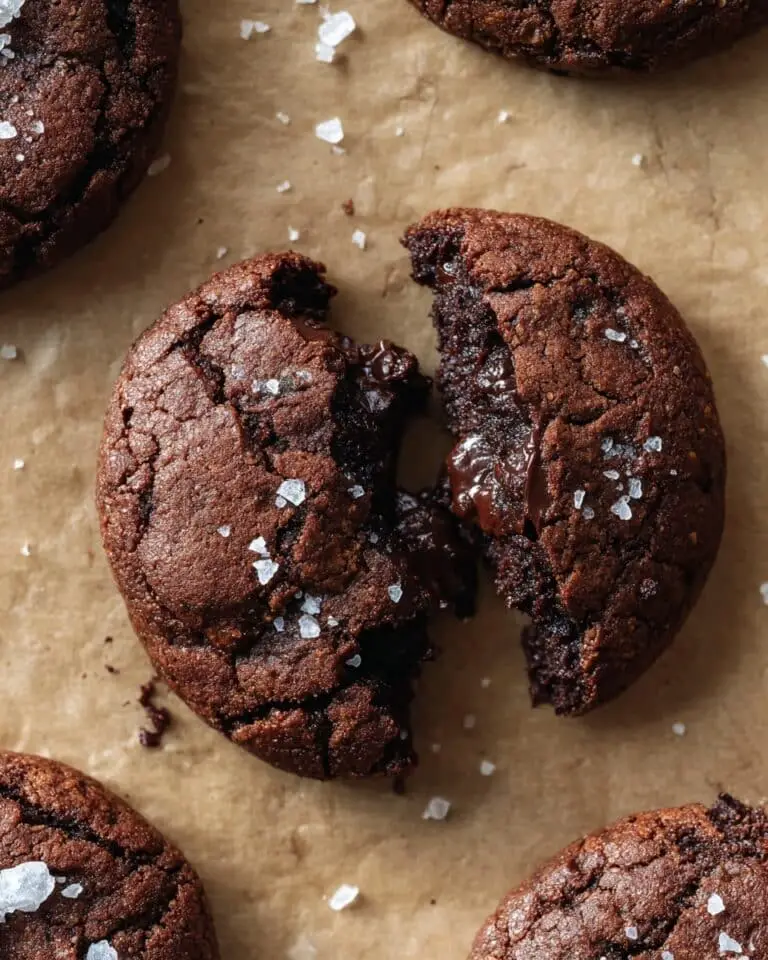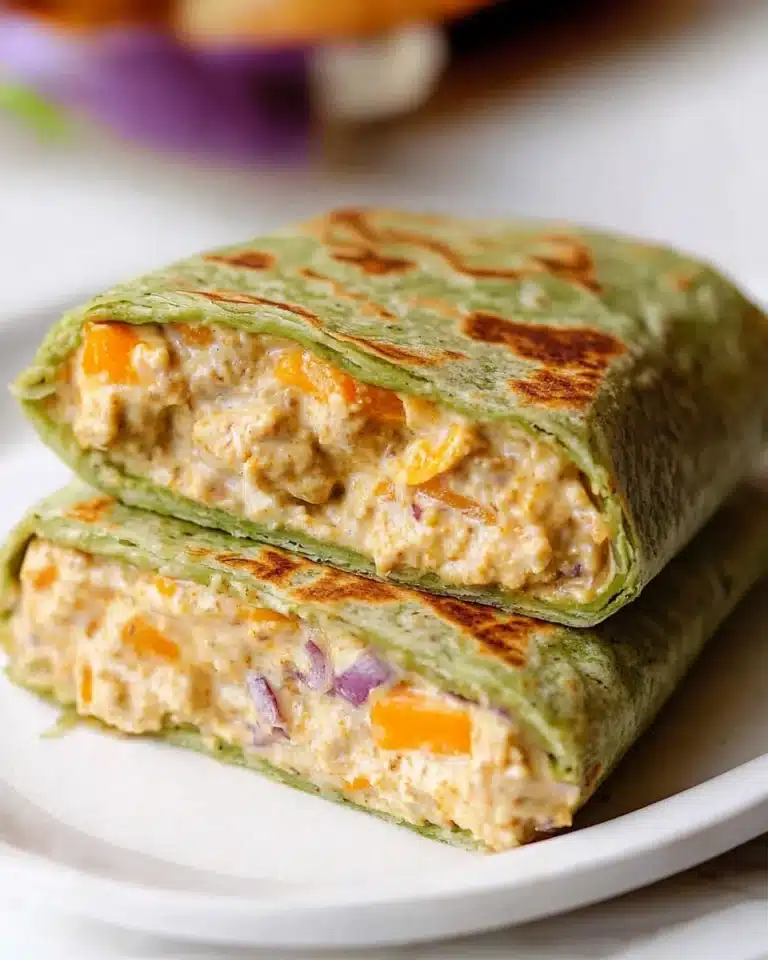I absolutely love how this Baked Feta and Butternut Squash Pasta with Sage and Garlic Recipe brings together cozy, comforting flavors in such an effortless way. When I first tried this dish, I was amazed by how the sweetness of the roasted butternut squash perfectly balanced the tangy creaminess of baked feta, all brightened up by fresh sage and garlic. It’s like a warm hug on a plate, perfect for cool evenings or anytime you want a satisfying yet simple dinner.
You’ll find that this recipe is not only delicious but also incredibly straightforward, making it a great weeknight meal or even a special dinner with friends. What makes this Baked Feta and Butternut Squash Pasta with Sage and Garlic Recipe stand out is the way everything bakes together in one dish, allowing those rich flavors to meld beautifully without a lot of fuss. Trust me, once you try it, it’ll be a staple you come back to again and again!
Why You’ll Love This Recipe
- One-Dish Wonder: Everything bakes together, minimizing cleanup without sacrificing flavor.
- Perfect Flavor Balance: Sweet squash, tangy feta, and earthy sage combine for a harmonious dish.
- Flexible Ingredients: Use your favorite pasta shapes and adjust spice or honey to taste.
- Family Favorite: My loved ones keep asking me to make this for gatherings and cozy nights in.
Ingredients You’ll Need
These ingredients come together to create a dish that’s not just comforting but also packed with layers of texture and flavor. Shopping for fresh sage and a good-quality block of feta makes a noticeable difference here.
- Butternut Squash: Choose a firm, unblemished squash for sweeter, more vibrant roasting results.
- Olive Oil: Use extra virgin olive oil for the best flavor boost.
- Kosher Salt: Enhances sweetness of the squash and balances feta’s tang.
- Red Pepper Flakes: Optional, but adds a nice gentle kick if you like a little heat.
- Feta Cheese Block: A solid block melts better than crumbled feta for that creamy baked texture.
- Pasta: Rotini, orzo, or ditalini work great to hold onto the sauce.
- Fresh Sage Leaves: Minced fresh sage adds earthy brightness that’s key to the flavor profile.
- Garlic: Fresh and finely minced to infuse the pasta with savory warmth.
- Hot Honey (or regular honey): Adds a subtle sweetness with a touch of heat; regular honey works if you want milder flavor.
- Fresh Cracked Black Pepper: For seasoning at several stages to lift the dish.
Variations
Sometimes I like to switch things up with this Baked Feta and Butternut Squash Pasta with Sage and Garlic Recipe based on what’s in season or my mood. Feel free to make it your own!
- Vegetarian Boost: Add toasted walnuts or pine nuts for crunch and extra protein – my family goes crazy for this twist.
- Spicy Kick: Increase red pepper flakes or swap hot honey for a drizzle of chili oil if you love heat.
- Greens Upgrade: Stir in baby spinach or kale right at the end for a fresh pop of color and nutrients.
- Gluten-Free: Use gluten-free pasta varieties and you’re good to go without compromising flavor.
How to Make Baked Feta and Butternut Squash Pasta with Sage and Garlic Recipe
Step 1: Roast the Butternut Squash and Feta
Start by preheating your oven to 400°F. Toss the cubed butternut squash with olive oil, kosher salt, and fresh cracked black pepper until everything is lightly coated. Spread the squash in a baking dish and nestle the whole block of feta cheese right in the center. Drizzle a bit more olive oil on the feta and sprinkle some red pepper flakes and pepper over the top if you’re using them. This simple prep gets those flavors intensifying in the oven over 30 minutes.
Step 2: Finish Roasting for a Golden Top
After 30 minutes, carefully move the squash around a bit—but don’t touch the feta—to prevent burning on the bottom. Now crank your oven up to 450°F and bake for another 5 to 10 minutes until the feta develops a beautiful golden, slightly browned top. Keep a close eye here; you want that toasted look without burning it.
Step 3: Cook the Pasta and Save Some Pasta Water
While the feta and squash finish roasting, boil your pasta in generously salted water according to package instructions until al dente. Once it’s ready, strain the pasta but save about two cups of that starchy pasta water – this is your secret weapon for creating a creamy sauce afterward.
Step 4: Mix Garlic, Sage, Honey, and Pasta with the Baked Ingredients
Remove the baking dish from the oven and immediately stir in minced garlic, fresh minced sage, and a tablespoon of hot honey (or regular honey if preferred). The heat will gently cook the garlic and release its flavor without bitterness. Then add the drained pasta and about one cup of your reserved pasta water. Stir everything together, letting the creamy feta and baking juices coat the pasta beautifully. If it feels a bit dry, gradually add more pasta water until you get a silky, saucy consistency.
Step 5: Final Seasoning and Serve
Give the pasta a final taste and add more salt, cracked pepper, or honey if you want it sweeter or spicier. This step’s all about tweaking to your preference – and trust me, it’s worth the little extra effort. Serve right away, so you can enjoy the contrast of warm roasted squash and creamy feta with the fresh herb kick.
Pro Tips for Making Baked Feta and Butternut Squash Pasta with Sage and Garlic Recipe
- Even Roast: Cut squash into evenly sized cubes for uniform roasting and caramelization.
- Watch the Feta: The higher heat step browns the feta nicely but keep an eye to avoid burning.
- Reserve Pasta Water: The starchy water is magic for binding sauce to pasta and creating creaminess without cream.
- Fresh Herbs Last: Add sage at the end to keep its bright flavor from becoming dull in the heat.
How to Serve Baked Feta and Butternut Squash Pasta with Sage and Garlic Recipe
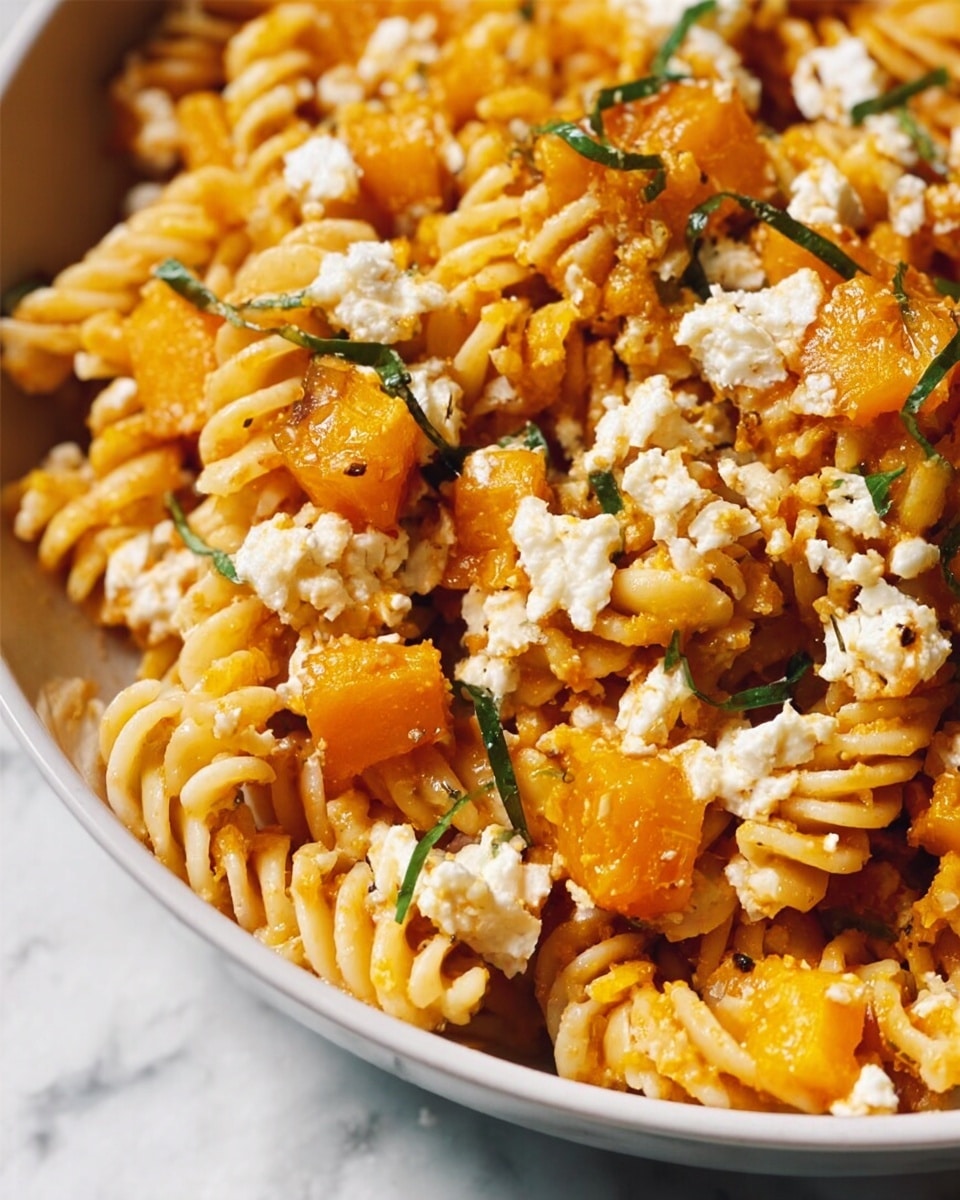
Garnishes
I like to finish this pasta with a sprinkle of extra fresh sage leaves or some toasted pumpkin seeds for crunch and a little fresh cracked pepper on top. A drizzle of extra hot honey right before serving always gets rave reviews in my house.
Side Dishes
This recipe pairs beautifully with a simple green salad tossed in lemon vinaigrette or roasted Brussels sprouts. Sometimes I serve it alongside crusty garlic bread, which is perfect for soaking up every last bit of that luscious sauce.
Creative Ways to Present
For a dinner party, I like to bake the feta and squash in individual ramekins and then toss the pasta at the table – it feels so fancy and lets your guests see that gorgeous baked block of cheese melting away. You can also add edible flowers or a sprinkle of finely grated Parmesan for an extra pop.
Make Ahead and Storage
Storing Leftovers
Leftovers keep really well in an airtight container in the fridge for up to 3 days. I usually add a splash of olive oil before storing to keep the pasta from drying out and to help preserve that lovely creaminess.
Freezing
I’ve frozen this pasta a few times – it freezes better than you’d think! Just cool it completely, portion it, and freeze in a sealed container. The texture may soften slightly, but the flavor remains spot on.
Reheating
When reheating, gently warm the leftovers on the stovetop with a splash of water or olive oil to revive the sauce’s creaminess. Avoid the microwave if you can, but if you do use it, heat in short bursts to keep the feta from getting grainy.
FAQs
-
Can I use other types of cheese instead of feta?
Feta’s tangy, salty creaminess is key to this recipe’s flavor, but you can experiment with other cheeses like goat cheese or ricotta salata. Just keep in mind their melt properties vary, so texture will change a bit.
-
What pasta works best for this recipe?
Short pasta shapes like rotini, orzo, or ditalini are ideal because they hold the sauce well and mix nicely with the baked ingredients. But feel free to use whatever you have on hand.
-
Is this recipe suitable for vegans?
Unfortunately, this recipe relies on feta cheese, so it’s not vegan. However, you could try using a vegan feta substitute to approximate the flavor and texture.
-
Can I make this recipe ahead of time?
You can definitely prep the roasted squash and feta a day ahead and reheat gently before tossing with fresh pasta. The flavors often taste even better the next day.
Final Thoughts
This Baked Feta and Butternut Squash Pasta with Sage and Garlic Recipe has truly become one of my go-to dishes when I want something both comforting and impressive that doesn’t require hours in the kitchen. I love how it combines simple ingredients into a rich, flavorful meal that’s perfect for sharing with family or friends. I really hope you give it a try—once you do, I’m confident it’ll become a favorite in your recipe rotation just like it did in mine!
Print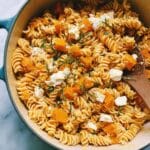
Baked Feta and Butternut Squash Pasta with Sage and Garlic Recipe
- Prep Time: 10 minutes
- Cook Time: 40 minutes
- Total Time: 50 minutes
- Yield: 4 servings
- Category: Main Course
- Method: Baking
- Cuisine: Mediterranean
- Diet: Vegetarian
Description
This Baked Feta and Butternut Squash Pasta with Sage and Garlic is a flavorful and comforting vegetarian dish that combines the creamy richness of baked feta cheese with the natural sweetness of roasted butternut squash. Enhanced with fragrant sage, garlic, and a touch of honey, this pasta is easy to prepare and perfect for a cozy weeknight meal.
Ingredients
Vegetables
- 5 cups Butternut Squash (about 1 large butternut squash)
Cheese
- 1 8 oz block Feta Cheese
Herbs and Spices
- 10 leaves Fresh Sage, minced
- 3 cloves Garlic, finely minced
- 2 hefty pinches Kosher Salt (just shy of 1/2 tsp), plus more for pasta water
- Fresh Cracked Black Pepper, to taste
- 1 hefty pinch Red Pepper Flakes (optional)
Oils and Sweeteners
- 1/2 cup Olive Oil, plus more for drizzling
- 1 tablespoon Hot Honey (regular honey is fine too)
Pasta
- 1 lb Pasta (such as rotini, orzo, or ditalini)
Instructions
- Preheat Oven: Preheat your oven to 400°F (204°C) to prepare for roasting the butternut squash and baking the feta cheese.
- Prepare and Roast Squash and Feta: Toss the cubed butternut squash with ½ cup olive oil, 2 hefty pinches of kosher salt, and a few turns of fresh cracked black pepper. Arrange in a baking dish and place the block of feta cheese in the center. Drizzle the feta with a little olive oil and sprinkle red pepper flakes and more black pepper. Bake for 30 minutes.
- Bake Until Feta is Slightly Browned: After 30 minutes, carefully shift the butternut squash pieces slightly to prevent burning on the bottom, avoiding the feta block. Increase the oven temperature to 450°F (232°C) and bake for an additional 5–10 minutes until the feta is golden brown on top.
- Cook Pasta: While the feta and squash are baking, bring salted water to a boil and cook the pasta according to package instructions until al dente. Reserve 2 cups of pasta water before draining.
- Combine and Flavor: Remove the baking dish from the oven. Immediately stir in the minced garlic, minced sage leaves, and honey into the hot feta and squash mixture. Add the cooked pasta and 1 cup of reserved pasta water, stirring to combine.
- Adjust Sauce Consistency and Season: If the pasta seems dry, gradually add more reserved pasta water until the sauce is creamy and smooth. Taste and adjust seasoning with additional salt, pepper, or hot honey as desired.
Notes
- For a spicier kick, increase the amount of red pepper flakes or use hot honey.
- Feta can be substituted with goat cheese for a milder flavor, but this will alter the texture slightly.
- Use gluten-free pasta if you want this dish to be gluten-free.
- Save some fresh sage leaves for garnish for an extra visual and flavor boost.
- Leftovers can be stored in an airtight container in the refrigerator for up to 3 days; reheat gently to avoid drying out.
Nutrition
- Serving Size: 1 serving (about 1/4 of recipe)
- Calories: 520 kcal
- Sugar: 7 g
- Sodium: 650 mg
- Fat: 22 g
- Saturated Fat: 7 g
- Unsaturated Fat: 14 g
- Trans Fat: 0 g
- Carbohydrates: 62 g
- Fiber: 6 g
- Protein: 18 g
- Cholesterol: 35 mg

